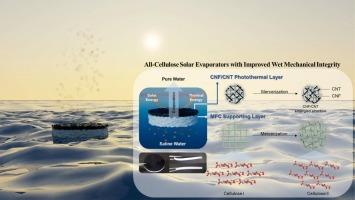全纤维素基太阳能蒸发器,通过丝光改善湿机械完整性
IF 12.5
1区 化学
Q1 CHEMISTRY, APPLIED
引用次数: 0
摘要
随着对可持续技术的需求不断增加,可再生能源驱动的水净化和海水淡化越来越受到关注。在这里,我们提出了一种新开发的全纤维素界面太阳能蒸发器系统,通过丝光增强了湿机械完整性。该装置由多孔微纤化纤维素支撑层和与碳纳米管集成的纤维素纳米纤维光热层组成。加工后的丝光处理,一种使用氢氧化钠的碱处理,诱导从纤维素I到纤维素II的结晶转变,从而改善纤维缠结和结构完整性。系统表征揭示了其坚固的结构和卓越的性能,在高强度模拟阳光(5 - 10 kW·m - 2)下,太阳能到蒸汽的能量转换效率高达95%,蒸发速率为15 kg·m - 2·h - 1,迄今为止报道的最高效率为3和5 kW·m - 2。它还显示出99.9%的普通盐和有毒重金属离子的拒斥,表现出自我再生的行为,突出了其长期野外使用的适用性。这些结果表明,丝光,一种相对温和的化学处理,有效地克服了纤维素基装置固有的湿强度限制,从而使其在可持续水净化中的实际应用。我们的研究强调了全纤维素、可生物降解的太阳能蒸发器在可扩展、环保的水处理解决方案中的潜力。本文章由计算机程序翻译,如有差异,请以英文原文为准。

All-cellulose-based solar evaporators with improved wet mechanical integrity via mercerization
With rising demand for sustainable technologies, renewable energy–driven water purification and desalination have gained increasing attention. Here, we present a newly developed all-cellulose interfacial solar evaporator system with enhanced wet mechanical integrity through mercerization. The devices consist of a porous microfibrillated cellulose supporting layer and a cellulose nanofibril photothermal layer integrated with carbon nanotubes. Post-fabrication mercerization, an alkali treatment using sodium hydroxide, induced a crystalline transformation from cellulose I to cellulose II, resulting in improved fiber entanglement and structural integrity. Systematic characterization revealed a robust structure and outstanding performance, with solar-to-vapor energy conversion efficiencies up to 95 % and evaporation rates of 15 kg·m−2·h−1 under high-intensity simulated sunlight (5–10 kW·m−2), as well as the highest efficiencies reported to date at 3 and 5 kW·m−2. It also demonstrates >99.9 % rejection of common salts and toxic heavy-metal ions, exhibiting self-regenerating behavior, highlighting their suitability for long-term field use. These results demonstrate that mercerization, a relatively mild chemical treatment, is effective in overcoming the intrinsic wet strength limitations of cellulose-based devices, thereby enabling their practical application in sustainable water purification. Our study highlights the potential of all-cellulose, biodegradable solar evaporators for scalable, eco-friendly water treatment solutions.
求助全文
通过发布文献求助,成功后即可免费获取论文全文。
去求助
来源期刊

Carbohydrate Polymers
化学-高分子科学
CiteScore
22.40
自引率
8.00%
发文量
1286
审稿时长
47 days
期刊介绍:
Carbohydrate Polymers stands as a prominent journal in the glycoscience field, dedicated to exploring and harnessing the potential of polysaccharides with applications spanning bioenergy, bioplastics, biomaterials, biorefining, chemistry, drug delivery, food, health, nanotechnology, packaging, paper, pharmaceuticals, medicine, oil recovery, textiles, tissue engineering, wood, and various aspects of glycoscience.
The journal emphasizes the central role of well-characterized carbohydrate polymers, highlighting their significance as the primary focus rather than a peripheral topic. Each paper must prominently feature at least one named carbohydrate polymer, evident in both citation and title, with a commitment to innovative research that advances scientific knowledge.
 求助内容:
求助内容: 应助结果提醒方式:
应助结果提醒方式:


